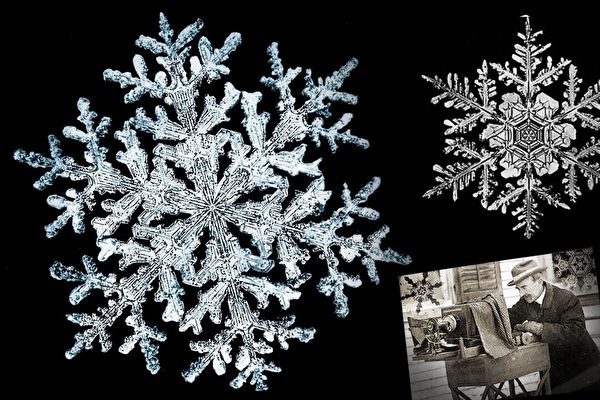In the vicinity of Jericho, Vermont, where most of the snow and ice have melted away, there remains some lingering remnants of winter. It is here that a world-renowned poet-scientist coined the classic phrase, “No two snowflakes are alike.”
He was a humble farmer. Back in 1880, when land was priced at $3 per acre, 15-year-old Wilson Bentley dreamt of attaching a new bellows camera to the microscope his mother had given him. His aspiration was to capture snowflakes through the lens, a pursuit that would become his lifelong passion and legacy.
The challenge was that the camera cost $100, which was an exorbitant sum at the time, as Sue Richardson, Bentley’s great-grandniece, explained, “No sane Vermonter was going to shell out that kind of money.”
“For his father, $100 equated to 33 prime acres of land, and being a farmer, he wasn’t willing to spend that much,” said the 67-year-old Richardson, who now manages the Snowflake Bentley Exhibit at the Historic Old Red Mill as a retired home care nurse.
In the end, it was the inheritance from Richardson’s mother’s parents that provided the funds. “He inherited that money in 1881,” she said.
A young Bentley had already set up a laboratory to explore the microscopic world, feeding his curiosity. The laboratory soon turned into a photographer’s studio. It wasn’t a proper lab; it was a shack with no heat. But fortunately, the young Bentley was accustomed to Vermont’s harsh winters. He often captured snowflakes on dark velvet, then attempted to sketch them on paper.
“He plucked a hair from a horse’s tail, touched it to the center of a snowflake, and then transferred the snowflake to a glass slide under the microscope,” Richardson said. He had to hold his breath so that these delicate structures wouldn’t melt as he drew.
“He drew about 400 snowflakes,” she said, “but one day, he realized that his drawings were so inaccurate compared to what he was seeing.”
His bellows camera finally arrived, but there was still a long way to go in capturing the intricate crystal images for which he would become renowned, as young Bentley had to figure out the specific techniques of microphotography. On January 15, 1885, after spending the entire winter taking photographs, he found a pinhole small enough not to overexpose his fragile instrument, and Mr. Bentley succeeded in capturing the world’s first snowflake photo.
Richardson’s grandmother told her that after three years of arduous trials, the young man wanted to kneel in worship before the great camera because his dream had finally become a reality. Though he had no formal education, Bentley became a sought-after source of meteorological knowledge and a fount of intuitive wisdom in the scientific realm. The mainstream scientific community had done its best to ignore him until they could no longer.
But most importantly, his simple and beautiful snowflake photographs told the whole story.
They were almost magical, something the world had never seen before. Soon, he was sought after by major museums and publications. “His work was featured in scientific journals, National Geographic magazine, all over,” Richardson said, “colleges and universities around the world wrote to him wanting to buy his negatives for educational purposes.”
She told the Epoch Times, “His antiquated contraption somehow revealed the intricate patterns and designs of winter nature with a clarity that surpasses today’s technology.
“The photos are different now, more three-dimensional, whereas his were more two-dimensional,” she said, calling Bentley a man “far ahead of his time.”
“He sold them for 5 cents apiece, that was his fee, the cost to make a reproduction,” she said, “he never raised his prices because he did the work not for money. For him, it was about sharing this beautiful gift with the world.”
Like many pioneers and geniuses, Bentley was seen as an outsider by some, especially his fellow townspeople who thought he was crazy. To the farmers in Jericho, snow was worthless. His great-granddaughter said, “It wouldn’t add to your crop yield or make your cows produce more milk.”
However, the 5,381 snowflake portraits he ultimately created became his life’s work, cherished by many. Tiffany purchased a set for jewelry design, and Harper’s Bazaar featured his work. With the Boston Globe, he became known as the “Snowflake Man.” In 2023, the London Natural History Museum digitized 80 of his works, ensuring his crystal microphotography would be immortalized.
Bentley left a legacy in the scientific field, encouraged by Vermont University Professor George Perkins, who urged him to write his first scientific article. He gave lectures all across the country. His theories on how snowflakes form in the atmosphere were influential, and he invented a method using a flat-bottomed pan and flour to measure the size of raindrops, a method still in use today.
“In his scientific writings, he tended to express poetically, that was his nature,” Richardson said, “I often tell people, Wilson Bentley had the mind of a scientist and the soul of a poet.”
The greatest tragedy of how he achieved his life goal lies in how he met his end. He hurriedly walked back home, wanting to capture more photos before missing the storm, clad in inadequate clothing and shoes, crossing over hills and ridges. While Mr. Bentley made it home safely, the weather took its toll. He succumbed to pneumonia on December 23, 1931, at the age of 66.
“He was a kind and gentle man, a humble farmer who just wanted to share this beautiful discovery with the world,” said his great-granddaughter, “promoting her hometown and family history was her ‘best retirement job.’ In fact, 92 years after his passing, he continues to share beauty with the world, an extraordinary feat.”

